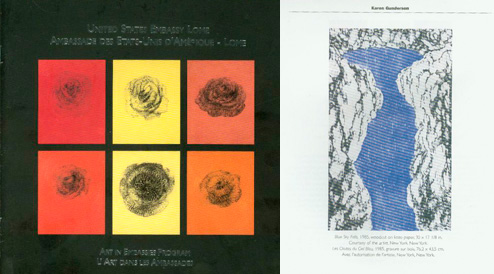Essay
U.S. DEPARTMENT OF STATE
ART IN EMBASSIES PROGRAM
An Exhibition of Contemporary Art
By and About Women

"The entire series of paintings- Aren’t We All Beautiful Colors?- began with twenty-four of them entitled A Couple Dozen Roses. When I first began these paintings in 19991, I first painted black roses- twelve of them- then covered them with singular colors of paint- the color of roses- and titled them, using their individual colors as their names, i.e. clear red rose. Each of the black underpaintngs is painted from life and each color laid on top is very close to the colors of roses that I found to paint from.
For the next twelve I wanted to push the idea of color. Not just color for color’s sake or pretty colors, but color as a whole ideology about all of us. I wanted to show the varieties of colors that we are- as roses are. I named them all after old friends."
-Karen Gunderson, 1995
Other historical facts also mitigated against an altogether self-congratulatory series of “heroic portraits.” Denmark had, after all, shut its borders to German Jews during the 1930’s when they had desperately sought refuge from the Nazi state next door. The national, self-aggrandizing story of rescue is complicated further by newly emerged historical evidence (also portrayed here) that it may have been the Nazi S.S. commander of the German occupation forces himself who tipped off the Danish underground to the impending roundup of Denmark’s Jews¾and that he may even have turned a blind eye to the rescue operation itself. The formally articulated ambivalence in Karen Gunderson’s black-on-black “anti-heroic” portraits is not intended to refute Denmark’s reigning self-idealization as a perennial haven of refuge, but only to pierce the self-congratulatory side of any national story that blinds us to other, conflicting historical realities. For the artist is aware that every national story necessarily occludes as much history as it recalls.
In Karen Gunderson’s vision, the heroism of King Boris III of Bulgaria, who prevented his country’s 50,000 Jews from being deported to the Nazi death camps, is similarly tinged with ambivalence. For it was partly through his accommodation toward the Nazi’s that he accomplished the actual rescue of the country’s Jews. Good and evil cleave together in this world, each defining the other, Gunderson’s portrait of King Boris III reflects the king’s mixed means toward a blessed end: his eyes are shaded, even masked slightly, preventing us from peering very deeply into his motives; bedecked with medals of the normally self-aggrandizing kind, the king also remains curiously oblivious to these customary signs of honor. His hat is part halo and part stiff military decorum, a mix of menacing and protective authority.
Only the two kings¾Christian of Denmark and Boris of Bulgaria¾are consecrated in paint here. The other rescuers remain suspended in the “drawing stage” of charcoal, works in progress, now fixed only for the purpose of our viewing. Charcoal is a kind of ash, of course, a medium created in fire and burning, which famously allows for shades of gray. Like black-on-black paint, charcoal does not hide the artist’s hand so much as reveal it through its traces, movements, and fingered smudges. Unlike black-on-black paint, the charcoal surface remains fragile, vulnerable to human touch, unfinished.
Of the individuals portrayed in the artist’s gallery of Bulgarian rescuers, “Eleven of the Many Brave,” none evince any trace of self-satisfaction. Their smiles are wan, if they smile at all, and two appear to be somewhat down-cast. The expressions on the other faces are decidedly cryptic and hard to read: all have their own stories, which they seem to be keeping to themselves. The reasons for their bravery may be as disparate as the individuals themselves.
On her drawing of King Boris III of Bulgaria with his back turned to a Nazi official berating him for not sending Bulgaria’s Jews to their deaths, the artist has remarked, “This drawing was incredibly difficult: not only to just make it, but to make it art.” For it is art that asks whether light can, or even should, be seen emanating from a time as dark as the Holocaust. Yes, the artist seems to answer, but only if it remains defined by the darkness itself. Such paintings and drawings represent not just the goodness of rescuers during the Holocaust, however inspiring such goodness may be. But they also underscore what historian Saul Friedlander has called “the ambiguity of good,” the mixed motives of rescue, its mixed legacy¾and our own ambivalent attempt to celebrate the goodness of rescuers even as we mourn the terrible loss of the unrescued.
Essay by James E. Young
James. E. Young is Professor and Chair of Judaic and Near Eastern Studies at the University of Massachusetts at Amherst; he curated “The Art of Memory” at the Jewish Museum in New York (1994). He is author of At Memory’s Edge (2000), The Texture of Memory (1993), and Writing and Rewriting the Holocaust (1988).